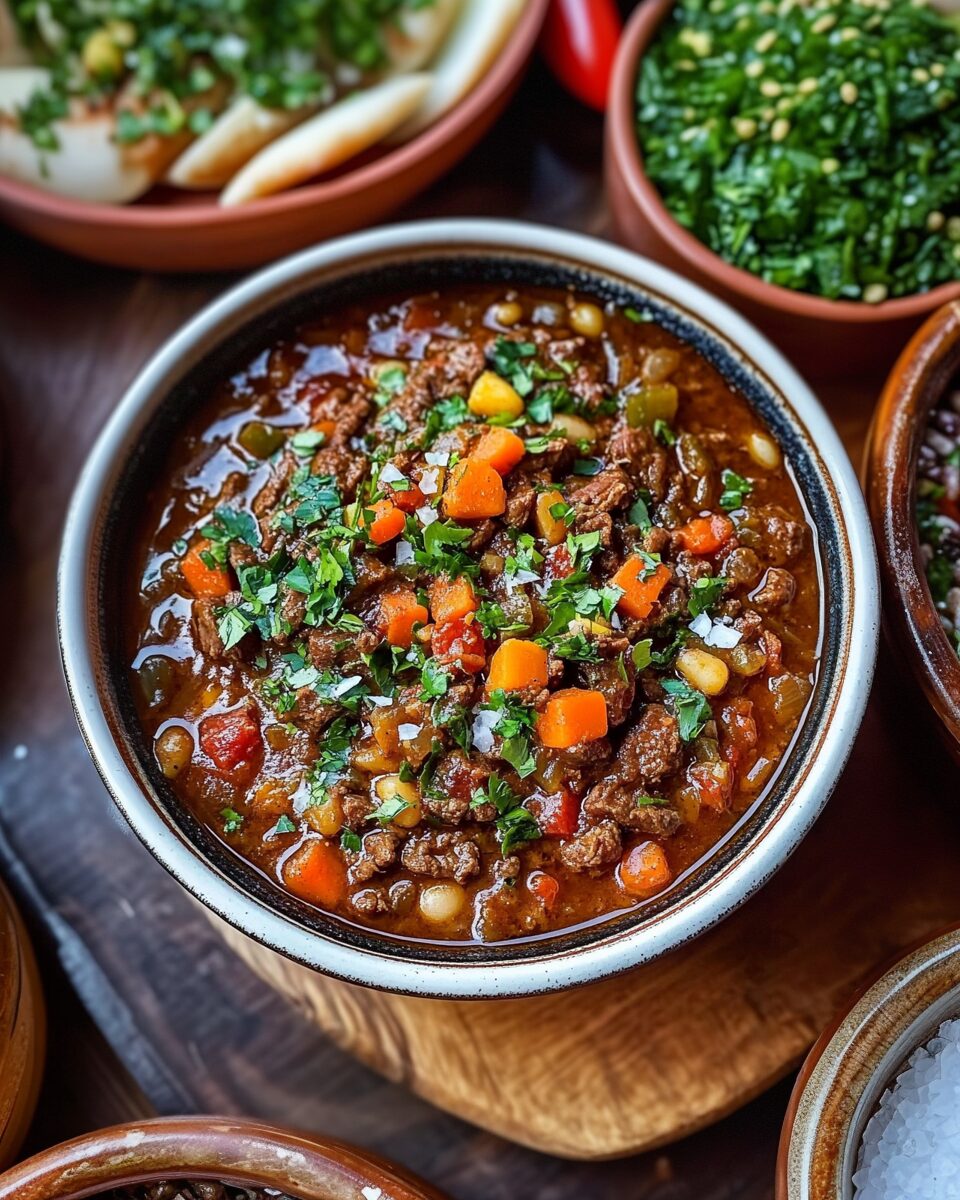This Moroccan Beef Tagine is a quick and flavorful twist on the traditional North African stew. By using ground beef instead of the customary cubed stewing beef, this version significantly reduces cooking time without sacrificing the rich, layered flavors characteristic of Moroccan cuisine. Infused with a blend of warm spices, sweet dried fruits, and savory elements, this dish offers a delightful balance of tastes and textures. It’s perfect for a hearty dinner and pairs well with rice, couscous, or flatbread.
Full Recipe:
Ingredients
- Ground beef
- Diced onion
- Diced carrot
- Minced or grated garlic
- Minced or grated ginger
- Paprika
- Ground turmeric
- Ground cumin
- Ground coriander
- Ground cinnamon
- Ground cardamom
- Cayenne pepper
- Tomato paste
- Beef broth
- Chopped dates
- Chopped dried apricots
- Raisins
- Sliced olives
- Chopped preserved lemon peel (pith removed)
- Honey
- Harissa
- Saffron
- Toasted sliced or slivered almonds
- Chopped cilantro (optional)
- Chopped parsley (optional)
Note: For specific quantities, please refer to the original recipe.
Directions
- In a large saucepan over medium-high heat, cook the ground beef, diced onions, and carrots, breaking the beef apart as it cooks, until the beef is browned and cooked through. Drain any excess grease.
- Add the minced garlic and ginger to the pan, stirring for about a minute until fragrant.
- Stir in the paprika, turmeric, cumin, coriander, cinnamon, cardamom, cayenne pepper, and tomato paste, cooking for another minute to toast the spices.
- Pour in the beef broth, then add the chopped dates, apricots, raisins, sliced olives, chopped preserved lemon peel, honey, harissa, and a pinch of saffron. Stir to combine.
- Bring the mixture to a boil, then reduce the heat to low and simmer uncovered for about 20-25 minutes, allowing the flavors to meld and the sauce to thicken slightly.
- Serve the tagine hot, garnished with toasted almonds and, if desired, chopped cilantro and parsley.
Nutrients
Estimated per serving:
- Calories: Approximately 450 kcal
- Protein: About 25g
- Carbohydrates: Around 30g
- Fat: Approximately 25g
- Fiber: Roughly 5g
- Sodium: Estimated at 600mg
The Essence of Moroccan Tagine
Tagine dishes are an essential part of Moroccan cuisine, dating back centuries to the Berber tribes of North Africa. The tagine pot, typically made of clay, is designed to retain moisture and allow food to cook slowly over low heat. This method of cooking allows the ingredients to tenderize and develop deep, complex flavors over time. Although the traditional tagine was slow-cooked for several hours, modern adaptations, such as the Moroccan Beef Tagine, allow for a quicker preparation without sacrificing flavor.
A key feature of Moroccan cuisine is the use of spices. Morocco’s location at the crossroads of Africa and Europe made it a hub for spice trade, and as a result, Moroccan dishes are often vibrant with a mix of spices such as cumin, cinnamon, coriander, turmeric, and saffron. These spices not only enhance the flavors of the dish but also contribute to its health benefits. Many of these spices have anti-inflammatory, digestive, and antioxidant properties, making Moroccan tagine recipes as good for the body as they are for the palate.
The Role of Ground Beef in This Dish
In traditional tagines, lamb or beef is often used in chunks and cooked slowly to allow the flavors to meld. However, ground beef has become a popular variation, particularly for those who prefer a quicker and more accessible cooking method. Ground beef is a versatile and affordable option that cooks much faster than larger cuts of meat, making this dish perfect for busy weeknights or when time is limited.
Ground beef also absorbs the spices and flavors of the tagine sauce more effectively, creating a rich and flavorful base. It complements the sweet dried fruits and the tanginess of preserved lemons, a hallmark of many Moroccan dishes. This substitution does not detract from the authenticity of the dish, as ground beef provides a tender texture that is perfect for the tagine’s flavorful sauce.
Sweet and Savory: The Balance of Dried Fruits and Spices
One of the signature elements of Moroccan Beef Tagine is the pairing of savory beef with sweet dried fruits. Dates, apricots, and raisins add a natural sweetness that contrasts beautifully with the savory spices and the richness of the beef. The sweetness of the dried fruits is balanced by the heat from cayenne pepper and the tang of preserved lemons, creating a dish that is both flavorful and satisfying.
Dried fruits have been a staple of Moroccan cuisine for centuries, as they are both nutritious and a way to preserve fruits in a region where fresh produce is not always readily available. Dates, in particular, are a key ingredient in many Moroccan dishes due to their sweetness and health benefits. Dates are rich in fiber, antioxidants, and essential minerals like potassium and magnesium, which contribute to heart health and overall well-being.
The preserved lemons used in this tagine recipe are another essential element. These lemons are salted and fermented, creating a unique tartness and depth of flavor that is hard to replicate with fresh lemons. The sharpness of preserved lemons provides a bright contrast to the sweetness of the dried fruits, creating a harmonious balance in the dish.
Aromatic Spices: The Heart of Moroccan Cooking
Spices are the backbone of Moroccan cuisine, and the spices used in Moroccan Beef Tagine are no exception. The combination of cinnamon, cumin, turmeric, coriander, and cardamom creates a warming and fragrant base for the dish. These spices are carefully chosen to complement the sweetness of the dried fruits and the richness of the beef, creating a complex and aromatic flavor profile.
Cinnamon and cumin are two of the most common spices in Moroccan cooking. Cinnamon brings a subtle sweetness and warmth to the dish, while cumin adds an earthy, slightly smoky flavor that enhances the beef. Turmeric, with its golden hue, contributes a mild bitterness and pairs well with cumin, while coriander and cardamom add a citrusy and floral note, respectively. The addition of saffron, although optional, takes the dish to another level, adding a luxurious and aromatic touch that is characteristic of many Moroccan stews.
The use of harissa, a North African chili paste, adds a layer of heat and complexity to the tagine. Harissa is made from dried red chilies, garlic, olive oil, and spices, and it gives the dish a subtle, smoky heat that enhances the flavors without overwhelming them.
Health Benefits of Moroccan Beef Tagine
In addition to its rich and bold flavors, Moroccan Beef Tagine offers several health benefits. Ground beef, when consumed in moderation, provides a high-quality source of protein, iron, and other essential nutrients. The addition of vegetables like carrots and onions increases the fiber content, while the dried fruits provide vitamins, antioxidants, and natural sweetness without added sugars.
Many of the spices used in this dish also offer numerous health benefits. For example, cinnamon has been shown to regulate blood sugar levels and improve digestion, while turmeric is a powerful anti-inflammatory that promotes joint health and cognitive function. Cumin, coriander, and cardamom are known to support digestive health, alleviate bloating, and improve metabolism. The combination of these spices makes Moroccan Beef Tagine not only a flavorful dish but also a nutritious one.
The dish’s use of olive oil, a staple in Mediterranean and Moroccan cuisine, provides healthy fats that are good for heart health and overall wellness. Olive oil is rich in monounsaturated fats and antioxidants, which have been linked to reduced inflammation and a lower risk of chronic diseases such as heart disease.
Serving Suggestions for Moroccan Beef Tagine
Moroccan Beef Tagine is a versatile dish that pairs well with a variety of side dishes. Traditional accompaniments include couscous, a type of steamed semolina that absorbs the flavors of the tagine sauce, or flatbreads such as khobz, which can be used to scoop up the stew. Rice is another excellent option for serving with this dish, providing a neutral base that allows the bold flavors of the tagine to shine.
Conclusion
Moroccan Beef Tagine is a flavorful and satisfying dish that brings the essence of Moroccan cuisine to your table. With its rich spices, sweet dried fruits, and tender beef, this dish offers a beautiful balance of flavors and textures that will transport you to North Africa with every bite.






